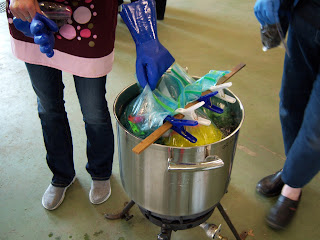After we returned from Kelowna, after my climb up Black Mountain to see what I could see, I had a few days of feeling well. We cleaned out the trailer and stored it for the winter. Mr. DD worked around the yard, preparing for cooler days ahead. I caught up with housework. But, somehow, things were not right. My energy levels were low. I had trouble eating and sleeping. We (me, family, doctors) all suspected that the anxiety and depression which nags me from time to time had returned, but nothing seemed to ease it. Then the story changed, Dramatically.
At the end of September, I was admitted to hospital where a CT scan of my belly showed a bowel obstruction. That scan showed something else - the breast cancer that I had worked on healing the past five years had returned. One month to the day before I was to receive my five year clearance and discharge from the Cancer Clinic, I learned that cancer had spread to the lining of my stomach and small bowel, into the bones in my pelvis and the lower spine. There's a strong likelihood that the new tests I'm scheduled to have this week will reveal more cancer.
When I was initially diagnosed, I had hoped to be the poster girl for healthy living, meditation and yoga as a treatment for cancer. After all, medically speaking, I shouldn't have cancer at all - the women in my family are strong and long-lived; I eat well, live well, practise my yoga and walk everywhere. All through surgery, chemo, radiation and hormone therapy, I practised. I received my 300 hour yoga teacher training certificate. Most days, I felt great. Although the overwhelming dread that comes with a cancer diagnosis always haunted me, I thought I knew how the story ended, with a full, long and happy life.
But. . . . Now, I'm facing that mountain again, preparing for the huge climb that will determine whether I have several years left to me, or a much shorter time. Facing one's own death clarifies the mind, but still, I can't imagine myself in non-existence, a non-being. No yogic or meditative training can prepare you for more than the theory of non-existence. Decisions must be made, based on how one wishes to live the rest of her life, whether treatment options will help or hinder that quality she wishes to have and how it will affect her determination to have a dignified death. Right now, I've decided to go for full on treatment. There are two small, unfinished tapestries I'd like to complete. There are projects my children have on the go that I'd love to see to fruition. There are a couple of projects of my own I'd like to be around to see through.
Besides, I like it here. I'm not much for thinking that death takes us to a better place. I may be wrong and I'm willing to take my chances on that, but HERE is a pretty good place to be. Right now, the last of the autumn coloured leaves are falling from the trees, carpeting the nearby park I call my Sanctuary in brilliant reds, golds and oranges. The air smells crisp and clear. I've climbed a few mountains and I'd like to climb a few more, actual ones, not metaphorical. I've walked in icy mountain lakes and talked to ravens. I watched wheat fields sprout, ripen and turn to chaff again. There were bluejays outside my living room window this week (and they weren't playing baseball). I think there are things I can still offer as a teacher and a writer. I'm not dead yet.
I'm not dead yet, but the story has changed and, by necessity, if not by choice, so will this blog. I'm not sure how often I'll write. Although writing keeps me grounded, there are days when I have only so much energy to spare and I must choose my tasks wisely. The work I wish to do now has a greater sense of urgency to it, but reporting on it does not. I'm also not big on "poor me" stories, so if this blog threatens to become that, I'll let it go.
In the mean time, I'm still not dead yet. (I have been resting a lot, although not on a perch.) The story has changed; I'm not getting the lines I wanted, but there's still a story. Every day, I look out my window and am amazed at the beauty of the world. Every day, friends, some of whom I didn't even realize were friends, support me and my family and renew my faith in humankind.
I've already cast my ballot for Monday's federal election. I'm hoping to see an evil force driven out of our country so that some sense of balance and community can be restored. The thing is, no matter what fortune brings me, there is always work to be done, the work of my conscience and my spirit. Everything depends on taking it one breath at a time. As Jon Kabat-Zinn says, "As long as you are breathing, there is more right with you than wrong with you."
And so I BREATHE.
Namaste.


















































